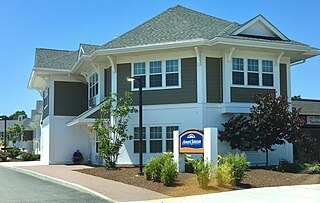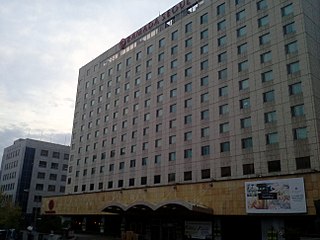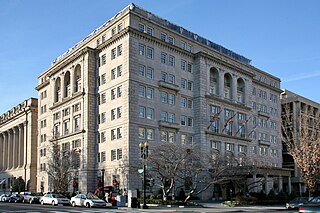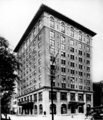
Howard Johnson's, or Howard Johnson by Wyndham, is an American hotel chain with locations worldwide, as well as a former restaurant chain. The chain began as a restaurant founded by Howard Deering Johnson in 1925; in the 1950s, the company expanded operations by opening hotels, then known as Howard Johnson's Motor Lodges, which were often located next to restaurants. Throughout the 1960s and 1970s, it was the largest restaurant chain in the U.S., with more than 1,000 combined company-owned and franchised outlets.

Sheraton Hotels and Resorts is an international hotel chain owned by Marriott International. As of June 30, 2020, Sheraton operates 446 hotels with 155,617 rooms globally, including locations in North America, Africa, Asia Pacific, Central and South America, Europe, the Middle East and the Caribbean, in addition to 84 hotels with 23,092 rooms in the pipeline.

Ramada is a large American multinational hotel chain owned by Wyndham Hotels & Resorts. As of December 31, 2022, it operates 851 hotels with 120,344 rooms across 63 countries under the Ramada brand.

The Hay–Adams is an historic luxury hotel opened in 1928, located at 800 16th Street NW in Washington, D.C. It south-fronts on Lafayette Square across from the White House. It sits on the former site of the connected 19th-century mansions which were owned by influential friends John Hay and Henry Adams, giving the hotel its name.

Warren and Wetmore was an architecture firm based in New York City, a partnership established about 1889 by Whitney Warren (1864–1943) and Charles D. Wetmore (1866–1941). They had one of the most extensive practices of their time, and were especially known for having designed many large hotels.
Tishman Realty & Construction Co., Inc. is an American corporation founded in 1898 that owns and develops real estate. The company is known for being the contractor that built the original World Trade Center in New York City. Tishman Construction Corporation, the construction division of the company, was sold to AECOM in 2010.

The Hotel Wolcott is a hotel at 4 West 31st Street, between Fifth and Sixth Avenues, in the Midtown South neighborhood of Manhattan in New York City. Constructed between 1902 and 1904 by developer William C. Dewey, it was designed by John H. Duncan in the French Beaux-Arts and neoclassical styles. The hotel's namesake was Henry Roger Wolcott, a businessman, politician, and philanthropist. The hotel is a New York City designated landmark.

The General Motors Building is a 50-story, 705 ft (215 m) office tower at 767 Fifth Avenue at Grand Army Plaza on the southeast corner of Central Park, in Manhattan, New York City. The building occupies an entire city block between Fifth Avenue, Madison Avenue, 59th Street, and 58th Street on the site of the former Savoy-Plaza Hotel. It was designed in the International Style by Edward Durell Stone & Associates with Emery Roth & Sons and completed in 1968.

The Marbridge Building is an office building at 1328 Broadway, on the east side of Sixth Avenue between 34th and 35th Streets in Herald Square, Manhattan, New York City. It opened in 1909, an 11-story structure, utilized in part by men's clothier Rogers Peet. Until October 1910 it stood opposite the Alpine apartment house, which was at the northeast corner of Broadway and 33rd Street. The Alpine and old stores between 33rd and 34th Streets were demolished to make room for the $5,000,000 Hotel McAlpin near the end of 1910. On the other side of Broadway were located the Macy's Herald Square and Saks Incorporated stores, with the Gimbels store just below.

The Taft Hotel building is a 22-story pre-war Spanish Renaissance structure that occupies the eastern side of Seventh Avenue between 50th and 51st streets, just north of Times Square, in the Midtown Manhattan neighborhood of New York City. In its modern configuration, it features two separate portions with their own entrance on 51st Street. The larger portion is devoted to the residential condominium called Executive Plaza, with each of its 440 units being privately owned. Certain units are rented by their owners to the public. A smaller portion of the building contains The Michelangelo, a Starhotels hotel.

Red Lion Hotels is a full-service, midscale hotel brand owned by Red Lion Hotels Corporation.

The Cartier Building, also 653 Fifth Avenue, is a commercial building on the southeast corner of 52nd Street and Fifth Avenue in the Midtown Manhattan neighborhood of New York City. The building serves as the flagship store of Cartier in New York City. It consists of two conjoined residences completed in 1905: the Morton F. Plant residence at 651–653 Fifth Avenue, designed by Robert W. Gibson, and the Edward Holbrook residence at 4 East 52nd Street, designed by C. P. H. Gilbert.

The Peninsula New York is a historic luxury hotel at the corner of Fifth Avenue and 55th Street in the Midtown Manhattan neighborhood of New York City. Built in 1905 as the Gotham Hotel, the structure was designed by Hiss and Weekes in the neoclassical style. The hotel is part of the Peninsula Hotels group, which is owned by Hongkong and Shanghai Hotels (HSH). The structure is 23 stories high and, as of 2022, contains 241 rooms.

The Fairmont Washington, D.C. Georgetown is a luxury Postmodernist-style hotel located at 2401 M Street NW in Washington, D.C., in the United States. The structure, in the West End neighborhood of the city, opened in December 1985 as The Westin Hotel. In December 1989, Westin sold the hotel to All Nippon Airways, which operated it as the ANA Hotel. Lowe Enterprises purchased the hotel in October 1998, and renamed it the Washington Monarch Hotel. A $12 million renovation followed in 1999. Lowe Enterprises sold the hotel to Legacy Hotels Real Estate Investment Trust in October 2002, and Legacy contracted with Fairmont Hotels and Resorts to manage the hotel. The hotel was renamed The Fairmont Washington, D.C. Legacy was itself purchased by Cadbridge Investors in July 2007 and the hotel sold to MetLife in 2014, although the property remained branded a Fairmont. A $27 million renovation was completed in January 2017.

The Hotel Manger, renamed the Hotel Madison in 1959, was a hotel in Boston, Massachusetts, United States, that operated from 1930 to 1976. It was attached to North Station and the Boston Garden. In 1983, the building was demolished to make way for the Thomas P. O'Neill Jr. Federal Building.

The Tucson Inn is a motel located in Tucson, Arizona, in an area now known as the Miracle Mile Historic District. The motel was built in 1953 in the Googie architecture and Modernist style, and is an example of historic 1950s Mid-century modern highway motel architecture.

Historic Hotels of America is a program of the National Trust for Historic Preservation that was founded in 1989 with 32 charter members; the program accepts nominations and identifies hotels in the United States that have maintained their authenticity, sense of place, and architectural integrity.

647 Fifth Avenue, originally known as the George W. Vanderbilt Residence, is a commercial building in the Midtown Manhattan neighborhood of New York City. It is along the east side of Fifth Avenue between 51st Street and 52nd Street. The building was designed by Hunt & Hunt as part of the "Marble Twins", a pair of houses at 645 and 647 Fifth Avenue. The houses were constructed between 1902 and 1905 as Vanderbilt family residences. Number 645 was occupied by William B. Osgood Field, while number 647 was owned by George W. Vanderbilt and rented to Robert Wilson Goelet; both were part of the Vanderbilt family by marriage.

4 Park Avenue is a 22-story building in the Murray Hill neighborhood of Manhattan in New York City. Designed by Warren and Wetmore, the structure was built for Alfred Gwynne Vanderbilt and opened in 1912 as a hotel. It is along the west side of Park Avenue between 33rd and 34th Streets. Following a renovation by Schuman, Lichtenstein & Claman between 1965 and 1967, the top 18 stories have been used as residential apartments. The lowest three stories above ground, as well as three basement levels, are used as commercial space and carry an alternate address of 6 Park Avenue. As of 2021, the building is owned by The Feil Organization.
































